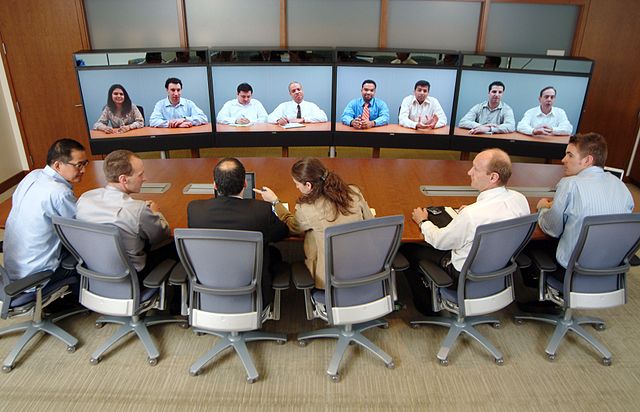
Image source: Wikimedia
Most everyone in business is used to sitting around a table to deliver reports, resolve issues, or hear instructions. With the rise of remote workers, telecommuting and a global economy, meetings have taken a different turn. Rather than gathering a group to sit around a table, many organizations now conduct virtual meetings. PR and marketing are especially likely to include remote team members.
That greatly changes meeting dynamics and can impair meeting effectiveness. Lack of visual cues hampers communications. Greater geographic distance may change how we feel about others. Research shows that shared identity may disintegrate and lead to an us-vs-them mentality and greater conflict, writes organizational behavior expert Mark Mortensen, in Harvard Business Review. Despite improving video conference technology, managing virtual meetings remains challenging. Technology can only go so far in cultivating relationships.
Tips for Running Virtual Meetings
The following advice can help PR, marketing and other executives better manage virtual meetings.
Stress the team’s goal. Retain the same best practices for managing virtual teams as people in same room meetings. A team is a team whether in one room or spread across the globe, says Mortensen, an associate professor of organizational behavior at INSEAD, a graduate business school. Stressing the team’s goal is probably the most important tenet of managing meetings. Ensuring that the team’s goal is clear, challenging, consequential, and commonly promotes unity builds a strong sense of shared identity, he says.
Get to know me – and everyone. Distance decreases our knowledge about team members, both professional and personal, which can harm the group’s effectiveness. Group effectiveness can improve if virtual team members know about not only their virtual colleague’s work but also about their work environment, office politics, and even personal life events. “All of these affect the psychology of your dispersed colleagues and, therefore, how they react to you and the rest of the team,” Mortensen explains.
Get there early. Open the conference line 10 minutes early and designate the first part of the meeting to connecting with each other. If you’re leading the meeting, call in early to spend time chatting and encourage others to do so. Ask questions like: What’s happening in your country? How’s your family? Insist that participants call in on time and don’t recap what late arrivers missed.
Use names. During the meeting, use people’s names when you refer to their earlier comments. The practice encourages people to be more attentive and thoughtful and helps build a sense of community, says Paul Axtell, a personal effectiveness consultant and corporate trainer, in Harvard Business Review.
Publish an agenda. A clear agenda helps people think about and prepare for each topic. Agendas are especially important for those who speak English as a second language. Well-developed agendas include the time allocated for each topic, the topic’s goal, and contributions from participants. Plan on 20% more time than you think you need for each topic. Well-run meetings call for both accomplishing the agenda’s goals and gaining broad participation calling on people for input.
Take it slow. Without seeing people, it’s more difficult to understand conversations and know if others understand it. A slow pace allows openings for questions. Asking participants if they have questions or comments at the end of each topic also enhances group understanding.
Invest in technology. Seeing the non-verbal cues of team members can improve communications. Video conferencing technologies like Skype and Google Hangouts are free. “Invest in the associated hardware — including computers, webcams and large screens. It will pay back in spades,” says Jaleh Bisharat, senior vice president of marketing at Elance-oDesk, in an article for the Huffington Post.
Don’t waste people’s time. If an agenda topic is not relevant to some participants, either adjust the agenda or don’t ask those people to attend. And don’t extend meetings just to fill their allotted time. People are busy, and saving them time will likely save the organization money, Bisharat says.
Bottom Line: Virtual meetings are becoming more common as work moves from offices to cyberspace. Without the shared space of the same conference room, a virtual team can lose its shared identity, leading to decreased effectiveness. While far-flung teams can offer advantages, managing virtual meetings well requires an adept leader who makes sure that everyone attending understands the meeting goals and what was discussed and decided.
William J. Comcowich founded and served as CEO of CyberAlert LLC, the predecessor of Glean.info. He is currently serving as Interim CEO and member of the Board of Directors. Glean.info provides customized media monitoring, media measurement and analytics solutions across all types of traditional and social media.




